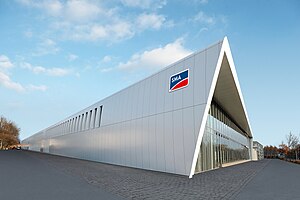SMA Solar Plant 1
The solar plant 1 of SMA Solar Technology is a solar inverter factory in Kassel . Due to its environmentally friendly and energy-efficient production, the plant was awarded 1st prize: Energy Efficiency Award 2010 by the German Energy Agency and was chosen in the 2011 competition of Germany - Land of Ideas in the Environment category.
Production facility
The production facility was put into operation in March 2009 and required investment costs of ten million euros. While the costs with conventional technologies would be only nine million euros, the plant saves around 1.1 million GWh in electricity costs with 6.2 GWh and an additional 2.3 GWh with 1.7 GWh in fuel. This saves a total of 1,700 t of CO 2 per year.
“With the new inverter factory, SMA Solar Technology AG has taken on a pioneering role in climate protection. It shows that ultra-modern, CO 2 -neutral industrial production can already be achieved today at a high technical level. "
The usable area of the solar plant is 26,000 m², of which 18,000 m² are used purely for production. Overall, the plant is 280 m long, 75 m wide and 12 m high, with twelve assembly lines spread across it. Up to 4,000 inverters can be produced daily under full load ; thus an inverter is completed every 30 seconds. This production technique is called SMArtflow and is intended to indicate that even changing a product family does not disrupt the production process.
In addition to production, each individual inverter is checked for 3.5 hours on one of the 624 test stations. The automatic device recognition takes place via RFID . The circuit voltage alternates between the inverters to be tested and the 104 test cabinets, which increases energy efficiency. The five percent unused thermal energy is also used as heating for the building.
Energy concept
electricity
The plant's photovoltaic system generates an output of 1.1 megawatts and, in addition to its own consumption, is also fed directly into the public grid . This has a positive effect on the CO 2 balance and contributes to CO 2 -neutral production, since unused energy can be passed on. If the electricity generated is insufficient, it is bought in as green electricity from the municipal utilities.
warmth
The main part of the heat in the plant is produced by a combined heat and power plant operated with bio natural gas , the other part is used from district heating . Additional heat is generated by the electric compressor , which is fed into the heat distribution system as waste heat.
cooling
Corresponding cooling is generated by the absorption chiller , which uses the heat from the block-type thermal power station to generate cold. In addition, the compression chiller works with electricity in the form of an air conditioning system , but is only used when it is needed - for example on warm summer days .
Web links
- Project presentation of solar plant 1 by the architects HHS Planer + Architekten AG, Kassel
- Construction analysis energy and building technology solar plant 1
Individual evidence
- ↑ a b c d Dena Energy Efficiency Award 2010 ( memento of the original from September 23, 2015 in the Internet Archive ) Info: The archive link was automatically inserted and not yet checked. Please check the original and archive link according to the instructions and then remove this notice.
- ↑ Germany - Land of Ideas ( Memento of the original from March 4, 2016 in the Internet Archive ) Info: The archive link was inserted automatically and has not yet been checked. Please check the original and archive link according to the instructions and then remove this notice.
Coordinates: 51 ° 18 ′ 45 ″ N , 9 ° 32 ′ 13 ″ E
